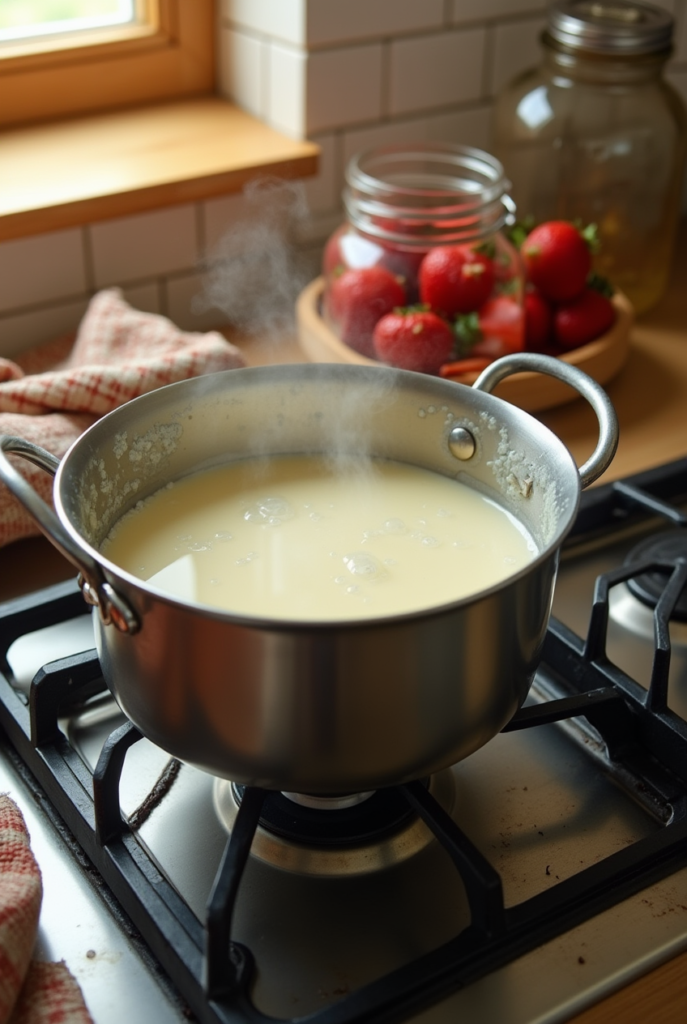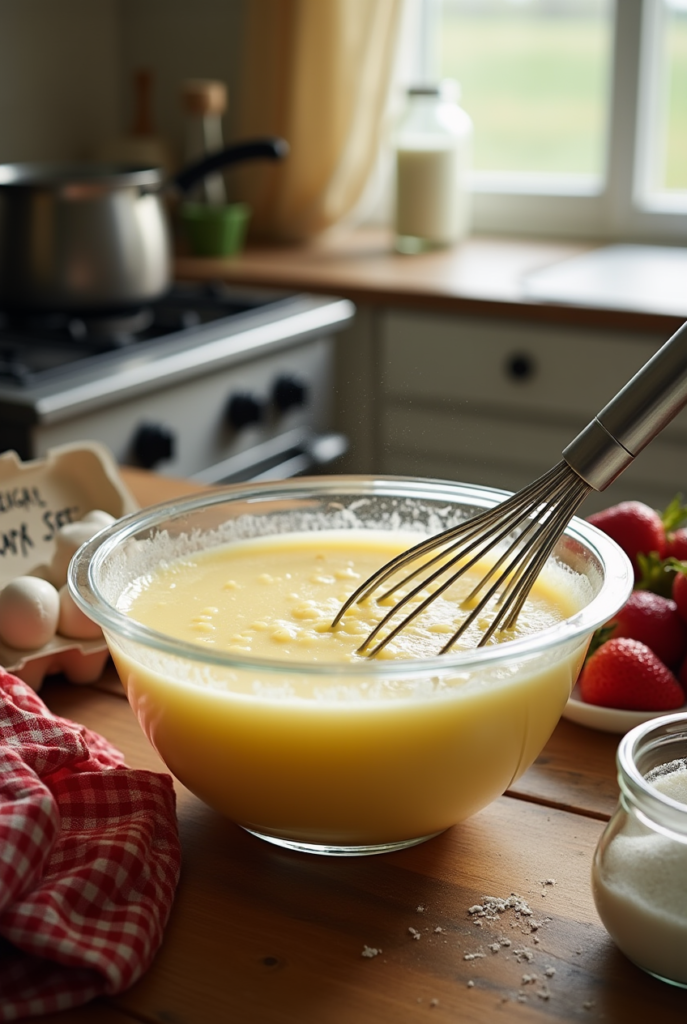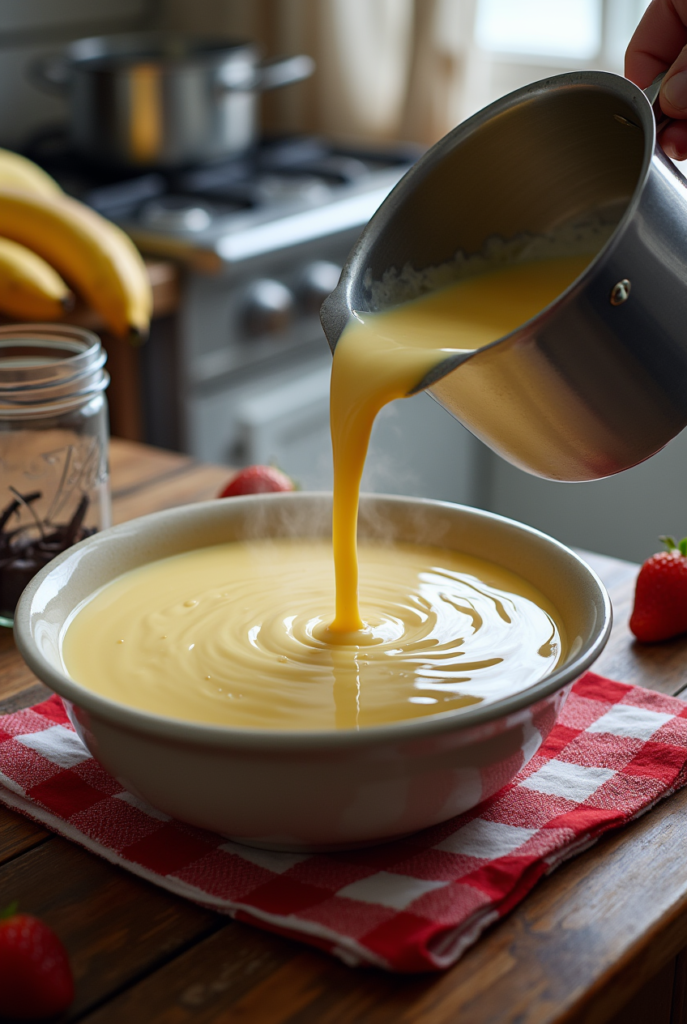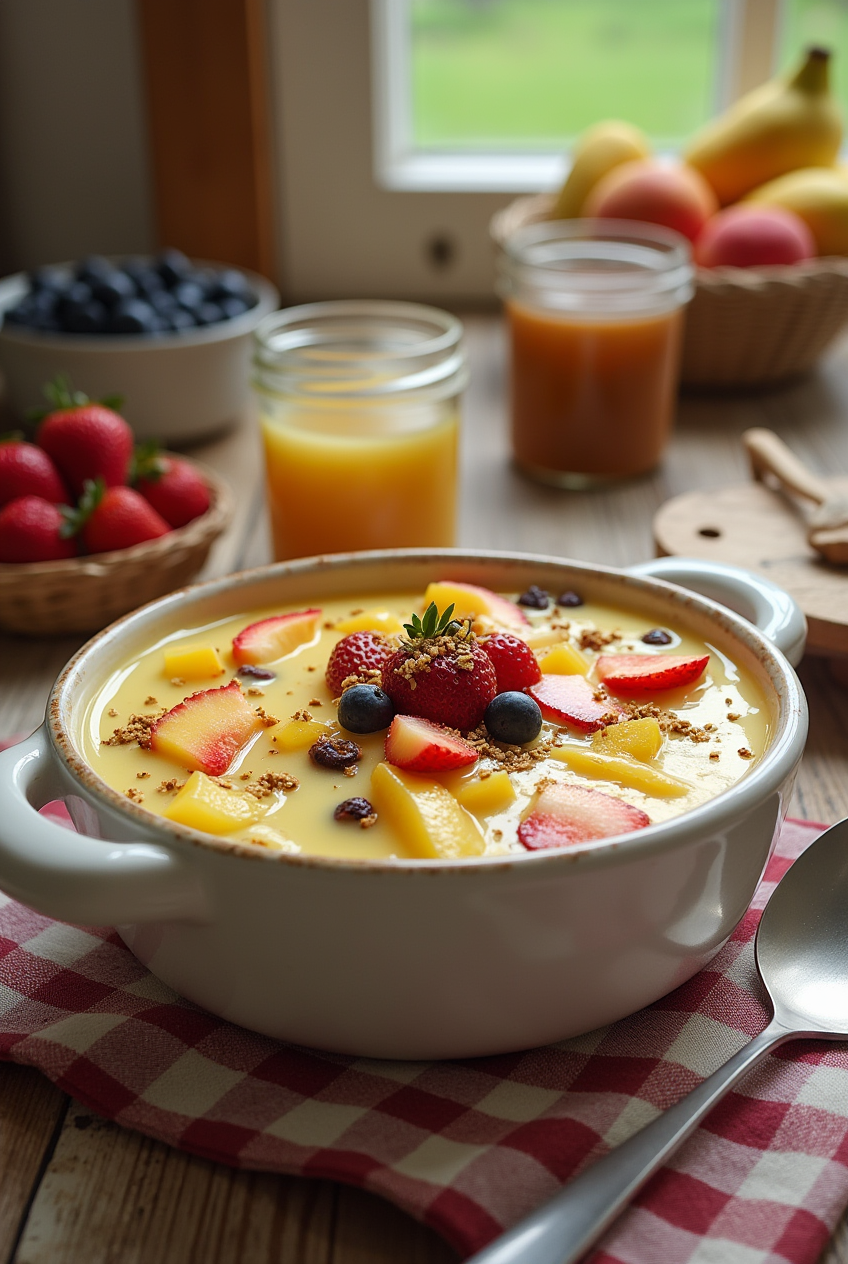Table of Contents
Make a vibrant dessert with this easy fruit custard recipe. It’s great for all skill levels. It mixes creamy custard with fresh fruits, making it elegant yet simple.
Use ripe fruits like strawberries, peaches, or berries for better taste. This recipe focuses on quality and easy steps. It shows that you can make beautiful desserts without spending hours cooking.
Key Takeaways
- Simple steps for creamy custard and fresh fruit combinations
- Works with any seasonal produce for year-round enjoyment
- Adaptable to dietary preferences or dietary restrictions
- Impressive presentation with minimal effort
- Perfect for both novice and experienced home chefs
Easy Fruit Custard Recipe
The fruit custard recipe has come a long way from ancient times to today’s kitchens. It combines old traditions with new ease. This dessert keeps its creamy, fruity essence alive.
A Brief Historical Look
Custard has been around for centuries, starting in medieval Europe. It was made with milk, eggs, and sugar for royal feasts. Over the years, cooks improved it, making it smooth and creamy.
Today, we have easy recipes like this one. They keep the flavor rich but are simpler to make. This makes it easy for anyone to enjoy.
Why Fresh Seasonal Fruits Matter
Choosing seasonal fruits makes your fruit custard recipe even better. In spring, strawberries and
summer peaches add natural sweetness. This means you can use less sugar.
Seasonal fruits are also packed with nutrients. Winter citrus has vitamin C, and autumn apples have antioxidants. Here’s a guide to picking the best:
- Spring: Strawberries, rhubarb
- Summer: Mangoes, peaches
- Autumn: Apples, pears
- Winter: Oranges, kiwis
Using in-season fruits makes your custard colorful and flavorful. It turns a simple dessert into a celebration of nature’s bounty.
Gathering Your Fresh Ingredients
Choosing the right fruit custard recipe ingredients is key to a tasty dessert. Fresh, seasonal fruits and top-notch custard ingredients are essential. Here’s how to pick each part with care.
Selecting the Best Fruits
Fruits should be ripe but not too ripe. Too soft berries or mushy pineapple can make the custard soggy. Look for fruits with bright colors and firm textures:
- Strawberries: Dry them well to avoid sogginess.
- Bananas: Use ripe bananas for natural sweetness.
- Peaches: Pick fruits that are slightly soft when gently squeezed.
Custard Ingredients Essentials
The custard base needs four main ingredients. Quality is important:
| Ingredient | Key Detail |
| Milk | Whole milk adds richness |
| Sugar | Adjust sweetness with granulated sugar |
| Eggs | Room temperature eggs mix better |
| Vanilla | Use pure extract for depth |
Always check expiration dates and choose local dairy for freshness. The right ingredients make every step simpler.
Mastering the Fruit Custard Recipe
Getting your fruit custard just right means finding the perfect mix of creamy and fruity. It’s all about blending flavors so each one shines. Start by tasting your fruits to see how sweet they are. This helps you know how much sugar to add to the custard.
Texture is key. Whisk the custard mix slowly over low heat to avoid lumps. Strain it before blending with fruit for a smooth finish. When adding fruits, mix gently to keep their shape and spread them out evenly.
- Use a rubber spatula to scrape the bottom of the pan while heating custard to prevent burning.
- Chill custard in shallow dishes for even setting—this prevents a watery consistency.
- Pair tangy fruits like pineapple with vanilla custard to balance acidity.
It’s easy to tweak the recipe. For a lighter custard, mix in ¼ of Greek yogurt with the milk. To add more flavor, heat the custard with a cinnamon stick. Always test a small batch first to adjust sweetness or texture. With practice, you’ll know when the custard is just right—thick enough to coat a spoon but still pourable.
Step-by-Step Preparation Guide
Learning to make homemade fruit custard begins with preparation. Follow these steps to mix everything perfectly:
Preparing the Fruit Components
Start by washing and drying your fruits. Cut softer fruits like berries or peaches thinly. Dice firmer fruits (apples, pineapples) into small cubes. Here’s a quick guide for common fruits:
| Fruit | Prep Method |
| Strawberries | Halve and remove stems |
| Bananas | Mash slightly for even mixing |
| Oranges | Peel and segment to avoid bitterness |
Mixing the Custard Base
1. Heat milk and vanilla extract in a saucepan until steaming (do not boil).

2. In a bowl, whisk eggs and sugar until pale and frothy.

3, Slowly pour hot milk into the egg mixture while stirring constantly.

Cooking Techniques for a Smooth Texture
- Simmer custard mixture over low heat, stirring nonstop for 8-10 minutes until thickened.
- Strain through a sieve to remove lumps before folding in prepared fruits.
- Pour into ramekins and chill in the refrigerator for at least 4 hours.
Adjust sweetness with lemon zest or cinnamon. Make sure to chill the homemade fruit custard evenly. Serve chilled for the best taste.
Quick and Easy Fruit Custard for Busy Evenings
When time is tight, the quick fruit custard is a lifesaver. It doesn’t need hours in the kitchen. Just smart swaps and simple steps. Start with store-bought custard mix or ready-to-use fruit cups to cut down prep time.
- Choose pre-sliced apples, peaches, or berries from brands like Dole or Chiquita.
- Opt for instant custard powder (like Carnation) that whips up in minutes.
- Use a microwave-safe bowl to cook the base in 2-3 minutes instead of stovetop simmering.
Layer the custard and fruit in a bowl or jar—no fancy plating needed. Chill for 15 minutes in the fridge before serving. Perfect for weeknights, this recipe turns leftovers like yesterday’s fruit into a treat.
“Speed shouldn’t mean sacrifice. A good dessert should adapt to your schedule.”
Pair ripe bananas or frozen mango chunks for instant sweetness. Even on busy days, the quick fruit custard delivers creamy satisfaction without compromising flavor. Save time without skipping quality—your family will never know you cut corners.
Healthy Variations and Seasonal Twists
Customizing the best fruit custard recipe is easy with these tips. You can make it healthier and tastier
by changing ingredients. Choose what you like and what’s in season.
Swapping Ingredients for a Nutritional Boost
Make your custard healthier without losing flavor. Try these swaps:
- Replace sugar with mashed banana or dates for natural sweetness.
- Use almond milk instead of dairy for a plant-based version.
- Add chia seeds to the mixture for extra fiber and protein.
- Opt for low-fat Greek yogurt to thicken without added fat.
Incorporating Local Produce
Seasonal fruits make the best fruit custard recipe even better. Here’s what to pick by season:
| Season | Fruits to Use |
| Spring | Strawberries, rhubarb, mango |
| Summer | Peaches, blueberries, pineapple |
| Autumn | Apples, pears, pomegranate |
| Winter | Oranges, kiwi, clementines |
Visit farmers’ markets for fresh, local fruits. For example, winter citrus adds vitamin C and keeps the custard creamy.
Troubleshooting Common Custard Concerns
Even with the best ingredients, fruit custard can sometimes go wrong. Don’t worry—these simple fixes help you recover quickly:
- Curdling: If your custard separates into lumps, it’s often from overheating. Remove from heat immediately and stir gently. To prevent this, use a custard texture base mixed with warm—not boiling—milk.
- Too Thick: Overcooking thickens the mixture. Add a splash of cream or milk and whisk until smooth. For consistency, stop cooking once it coats the back of a spoon.
- Fruit Discoloration: Browning fruits like apples or pears? Toss them in lemon juice before mixing. This keeps your fresh seasonal fruits vibrant and flavorful.
- Lumpy Texture: Lumps form when eggs aren’t fully incorporated. Strain the custard through a sieve after cooking. Next time, whisk ingredients slowly into the hot mixture.
Always use sharp knives to cut fruits evenly, ensuring they blend smoothly. If your custard smells burnt, discard and start fresh—burnt flavor won’t disappear. Practice adjusting ratios: a 1:1 egg yolk to sugar ratio often balances sweetness and creaminess. Store leftovers in an airtight container for up to 3 days. Remember, perfect fruit custard comes with practice—every mistake teaches what to avoid next time.
Tips for an Impressive Presentation
Making your fruit custard look good is as key as it tasting great. Follow these steps to make your dessert a hit:
Attracting the Eye with Color
Contrasting colors make freshness stand out. Bright berries like strawberries or kiwi look great with creamy custard. Try layering colors vertically for depth, like mango slices over vanilla custard for a tropical feel.
Plating Techniques
- Choose plates with neutral backgrounds to let colors pop.
- Spoon custard into a bowl, then arrange fruit slices in a circular pattern around it.
- Drizzle honey or caramel sauce in zigzag lines for texture contrast.
Garnishing Ideas
Small touches can make a big difference. Try:
- Finely chopped mint leaves for freshness.
- Edible gold dust sprinkled lightly over the top.
- Chocolate curls placed strategically around the edge.
Try seasonal fruits for a modern look. A raspberry coulis drizzle adds elegance without extra effort. Remember, presentation tells a story—let your creativity shine!
Family-Friendly Methods for a Memorable Experience
Cooking together turns kitchens into classrooms for life skills and laughter.
Make custard making a family-friendly activity that everyone will love. Getting everyone involved adds fun and teaches new skills. Here are some tips to make it a success:
Engaging Kids in the Kitchen
Let kids choose fruits or toppings. Give them simple tasks like stirring or arranging garnishes. Always use kid-safe tools and watch the heat closely. Their contribution makes the dessert even more special.
- Let them wash fruits and arrange slices.
- Use cookie cutters to shape fruit designs.
- Assign “taste testers” for final touches.
Simple Adjustments for Diverse Tastes
Change the recipe to fit everyone’s taste. The table below shows easy swaps to make it inclusive and tasty.
| Adjustment | Substitute | Example |
| Dairy-free | Coconut milk instead of milk | Use full-fat coconut milk for creaminess |
| Sweetness level | Honey or maple syrup | Add 1 tsp honey per serving preference |
| Allergy-friendly | Gluten-free flour | Use oat flour for thickening if needed |
Ask for family input on toppings or flavors. Small changes can turn a dessert into a family-friendly adventure that everyone will enjoy.
Conclusion
Making a vibrant fruit custard is all about quality ingredients and simple steps. This recipe combines classic custard with fresh fruits, making it both comforting and new. Using ripe fruits in season boosts flavor and nutrition.
Learning to make the custard base and how to plate it makes this dessert stand out. You can adjust sweetness or use plant-based options for different tastes. Adding unique fruits from local markets can make it even more special.
Sharing this recipe with family can create lasting memories. Even beginners can achieve smooth textures and beautiful looks. This recipe is perfect for any time, celebrating nature’s gifts. Enjoy making your own and relish the joy of a homemade dessert.
FAQ
What are the main ingredients needed for a fruit custard recipe?
To make fruit custard, you need fresh fruits, milk, sugar, and egg yolks. Cornflour and vanilla extract are also key. For a creamier version, add whipped cream or yogurt.
How can I make a quick fruit custard?
For a quick custard, use instant custard powder. Mix it with milk and sugar, then heat until thick. Add your favorite fruits before serving.
What fruits work best in a homemade fruit custard?
Great fruits for custard are bananas, strawberries, blueberries, mangoes, and kiwis. Pick fresh, ripe fruits for the best taste and look.
Can I prepare fruit custard in advance?
Yes, you can make the custard base ahead and chill it. But add fresh fruits just before serving to keep them fresh.
What are some healthy variations of fruit custard?
For a healthier custard, use almond or coconut milk instead of regular milk. Try natural sweeteners like honey or agave syrup. Add chia seeds for fiber and superfoods like acai or matcha for extra nutrition.
How do I troubleshoot common fruit custard issues?
If your custard curdles, cook it slowly and stir often. For thick custard, whisk in milk. If it’s too thin, cook a bit longer.
What plating techniques can make my fruit custard look more appealing?
Use clear glass bowls to show off the fruit and custard layers. Add mint leaves or edible flowers for a fancy look.
How can I make fruit custard a family-friendly treat?
Let kids help by picking and cutting fruits. You can also make the custard base to everyone’s liking. It’s a fun family activity.
